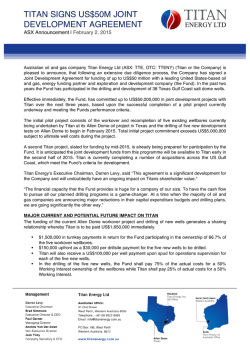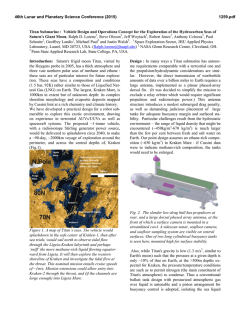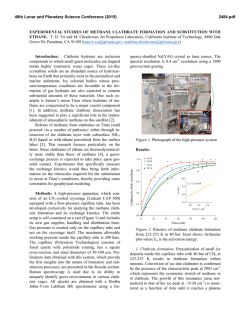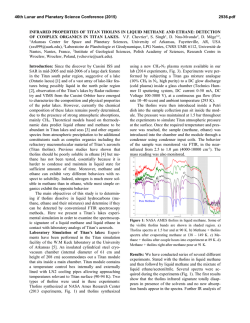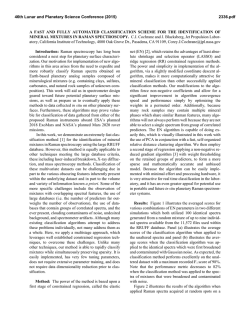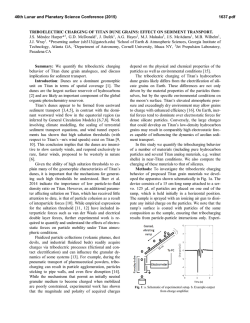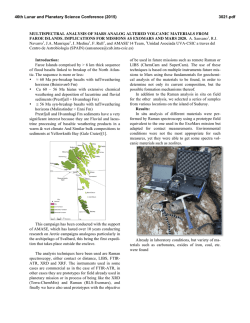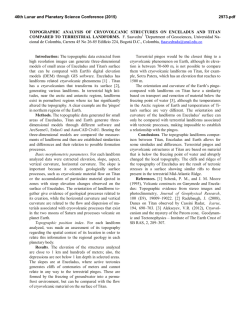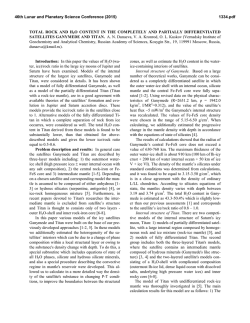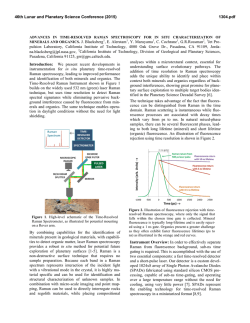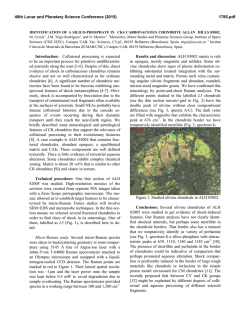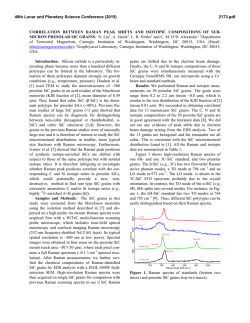
BENZENE-BASED CO-CRYSTALS ON THE SURFACE OF TITAN
46th Lunar and Planetary Science Conference (2015) 2078.pdf BENZENE-BASED CO-CRYSTALS ON THE SURFACE OF TITAN. Robert Hodyss1, Tuan H. Vu1, Morgan L. Cable1, Helen Maynard-Casely2, Mathieu Choukroun1, Michael J. Malaska1, and Patricia Beauchamp1 1Jet Propulsion Laboratory, California Instititute of Technology, Pasadena, CA ([email protected]) 2Australian Nuclear Science and Technology Organisation, NSW, Australia ([email protected]). Introduction: Titan is the only body in the Solar System aside from Earth that has standing liquid on its surface. Due to the low surface temperatures (90-95 K), this liquid phase is comprised of hydrocarbons, mostly methane and ethane, and nitrogen. Active photochemistry in the atmosphere due to solar radiation and energy from Saturn’s magnetosphere generates a plethora of organic molecules, from simple molecules to compounds >10,000 Da. These species are ultimately deposited onto the surface, including the lakes. Evaporation or other processes could potentially induce deposition of these organics, forming ‘bathtub rings’ similar to those observed by Cassini around some of the Northern lakes [1], and the southern lake Ontario Lacus [2]. These lake evaporites may play an important role in the surface chemistry of Titan. Our goal is to determine the properties and forms of organic evaporite deposits on Titan’s surface. We focus initially on benzene, which has been detected by Cassini in the Titan atmosphere and was tentatively identified on the surface by Huygens. Recent work in our laboratory shows that benzene has a very low solubility in liquid ethane (18.5 mg/L) [3], suggesting it is a likely constituent of possible evaporites of Titan lakes. Experimental: We performed a series of experiments in which solid benzene and liquid ethane were allowed to interact under Titan surface conditions (1 bar N2, 94 K). The interaction was studied using confocal Raman microscopy at 90 K in a liquid nitrogencooled cryostage (Linkam Scientific Instruments Ltd). Raman spectra within the cryostage were obtained using a high-resolution confocal dispersive micro-Raman spectrometer (Horiba Jobin Yvon LabRam HR) equipped with a Nd:YAG laser (frequency-doubled 532 nm, 50 mW) as the excitation source. Kinetics experiments were performed by condensing liquid ethane onto solid benzene at 90 K and warming to a specific temperature (110, 115, 120 and 125 K). Raman spectra were then obtained as a function of time. Infrared spectra were obtained using a Thermo Nicolet 6700 FTIR spectrometer equipped with a fiber optic ATR probe. X-ray powder diffraction experiments on the benzene:ethane co-crystal were conducted using the the powder diffraction (PD) beamline at the Australian Synchrotron (Melbourne, Australia). The PD beamline is ideally suited for these experiments, as it has facili- Figure 1. High-resolution Raman spectra of crystalline benzene before (black) and after (blue) incorporation of ethane in its lattice at 90 K. Note the emergence of a shoulder at 2873 cm−1 upon ethane incorporation. In comparison to pure solid benzene at 90 K (red), the υ7 mode at 3040−3050 cm−1 undergoes a red shift, while the frequency of υ1 mode at 3063 cm−1 remains unchanged. The spectrum of solid ethane at 80 K (yellow) is also included for reference. All spectra are vertically offset for clarity. ties already in place for cooling of the sample to cryogenic temperatures and condensing gasses onto the sample. Results and Conclusions: On the basis of optical microscopy and the Raman spectra, we identified the formation of a distinctive co-crystalline structure formed from benzene and ethane [4]. New features in the Raman spectrum at 2873 cm-1 and 1455 cm-1 were characteristic of the new structure (Fig 1). Additionally, recrystallization of the solid benzene was observed Figure 2. Microscope images of solid benzene before (left) and after (right) ethane incorporation, showing recrystallization during the formation of a new crystal structure. 46th Lunar and Planetary Science Conference (2015) during the co-crystal formation (Fig 2). The co-crystal is also observed to form from the evaporation of benzene saturated ethane solutions, as well as in the presence of mixtures of methane and ethane. Additional experiments were performed in order to characterize the temperature stability and kinetics of formation of the benzene:ethane co-crystal. We find that the co-crystal is stable up to ~150 K, and would form rapidly (<18 hours) at temperatures representative of Titan’s surface (94 K) [5]. Analysis of the powder diffraction experiments reveals that the crystal a 3:1 co-crystal of benzene:ethane, with a density of 1.067 g/cm3 at 90 K. The structure can be described as an inclusion compound, with each ethane molecule surrounded by six benzene molecules (Fig. 3). This results in channels containing ethane that run through the structure. The crystal appears to be bound through CH/π interactions between the benzene molecules. A paper describing these results is in progress [6] . Figure 3. The benzene ethane co-crystal, viewed down the c-axis. The stoichiometry is 3:1 benzene:ethane. Additional experiments were performed to search for the formation of co-crystals between benzene and methane, propane, and ethylene. Methane and propane do not appear to form co-crystals with benzene under Titan surface conditions. However, Raman spectroscopy of mixtures of benzene and ethylene appear to show an interaction that could be indicative of cocrystal formation. Experiments to study this system are ongoing. Our work suggests that the benzene:ethane cocrystal may be the dominant form of benzene on Titan wherever crystalline benzene has been in contact with liquid ethane, as in evaporite basins around ethane/methane lakes and seas. The benzene:ethane co-crystal represents a new class of materials for Titan’s surface, analogous to hydrated minerals on Earth. This new structure may also influence evaporite characteristics such as particle size, dissolution rate, and 2078.pdf infrared spectral properties. Future work will involve investigating new organic co-crystal structures and their characterization. Acknowledgements: Financial support through NASA’s OPR and ASTID programs, and through the NASA Astrobiology Institute (Titan as a Prebiotic Chemical System) is gratefully acknowldeged. References: [1] Barnes, J.W., et al., (2011) Icarus, 2316, 136-140. [2] Barnes, J.W. et al. (2009) Icarus, 201, 217-225. [3] Malaska, M.J. and Hodyss, R. (2014) Icarus, 242, 74-81. [4] Vu, T. H. et al. (2014) J. Phys. Chem., 118, 4087-4094. [5] Cable, M.L. et al. (2014) GRL, 41, 5396-5401. [6] Maynard-Casely, H. and Hodyss, R. JACS, in preparation.
© Copyright 2025
